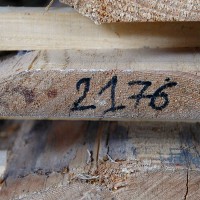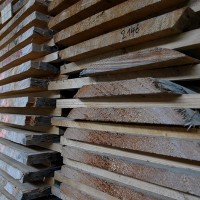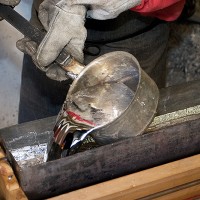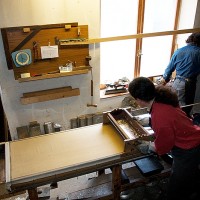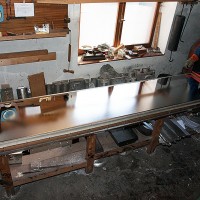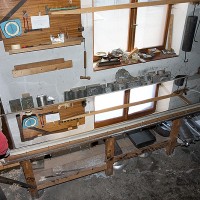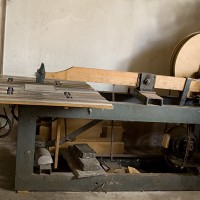Materials
Wood
Oak
All the oak wood that we use comes from hundred year old oak trees that have grown in our region. Climatic conditions and soil quality enable a slow and steady growth.
We only select butt logs and we choose before their cutting the purpose and the various thicknesses of the different saw-logs. We are present in the saw-mill during this important process.
The saw-logs to be used in the making of soundboards are washed in order to remove tannin. The saw-logs are then stored on stickers in our ventilated sheds. All our wood is kept naturally drying for several years.
When we are making parts for an organ, after being blank cut, the woods are put in waiting several weeks in our workshops before being used.
Softwood
We exclusively use conifers grown at a high altitude, preferably spruce trees from Hautes-Vosges or Haut-Jura. Their slow and steady growth ensures an excellent stability, required for the manufacturing of mechanical parts which must deform themselves as little as possible.
Furthermore, the physical characteristics of wood species decisively influence their sound quality. Thus we are committed to using coherent wood species with the aesthetics of every instrument we build.
Metal
Tin of England has long been the most popular with organ builders. These mines are exhausted and England has continued to extract tin in its colonies and specifically in Bangka Island (currently belonging to Indonesia). The Bangka Tin that we use to build the organ pipes is graded 99.99%. It is exclusively primary metal.
Lead has been coming for a long time from the mines of southern France. Since they have been abandoned, we are compelled to import lead from abroad, particularly from Poland.
The alloys of tin and lead are enriched with other metals such as copper and antimony in order to give them added strength, but also to modulate the sound of pipes. After being tapped on a marble table, the tin foils are planned and thinned towards the top of the pipes. They are then hammered, except in the case of restoring organs for which this technique was not used. These techniques have remained unchanged from the 18th century.
Leather
Most of the leather found today on the market is industrially produced with the chromium tanning technique. This tanning has certainly the advantage of making highly mechanically resistant leathers. However, chromium raises toxicity problems.
To avoid these risks, we have chosen to rely on a small-scaled tannery that produces only a few hundred hides per year. This is the only way to be certain that these hides are not treated with chromium, but with a mixed tanning base, made of alum and vegetable tannins. This technique consists in a pre-tanning with alum, followed by a bath in vegetable tannins. This process is significantly longer than the one of industrial tanning, but the qualities of leather are far better and it keeps it flexibility much longer.
We use bovine leather to line the bellows elements, because of its strength. To fit the valves in the soundboards, we use sheep or lamb hides. Finally, for the purses, we favour kid-goat hide, which more easily comply with this particular layout, while retaining its flexibility.
Glue
Natural animal glue
These adhesives are all derived from mammal collagen: solid extract is usually dissolved in water. Natural animal glue has the ability to gel once dry.
The Dictionnaire universel du commerce by Jacques Savary des Bruslons (1748) states:
Glue is made of hide from many of four-footed animals, such as cows, bulls, cows, calves, sheep, and so on. The older are the animals, the better is the glue made of their hide. However, complete hides which can be put to a better use are rarely consumed. Trimmings, otherwise called “orillions”, are merely used. At times, the paste is even made of oxen nerves and feet only. The best glue is made of bull hide, which is whitish & clear.
Dictionnaire universel du commerce by Jacques Savary des Bruslons, 1748
When looking for traditional organic adhesives, fish or mammal glue is still easily found on the market. We preferably use mammalian glue, fish glue remaining reserved for very specific uses.
Synthetic adhesives
These adhesives are composed of synthetic polymers. Usually flexible and transparent, they prove a strong tack and a good solubility. But as any industrial production they have their flaws, including the presence of additives which are not listed on data sheets.
Polyvinyl glue is known in the workshop language as “white liquid glue” because of its milky appearance. It consists of polyvinyl acetate emulsion, a synthetic polymer. This adhesive has extensively been used from the 1960s as an advantageous replacement for the traditional adhesives, since they can be implemented cold.
Polyvinyl glue is mainly used for assembling joinery or cabinetwork. Its bonding strength is higher than traditional glue and even if they are not guaranteed for an outdoor use, they much better support moisture. The major disadvantage of this adhesive is acidity. In contact with certain wood species, they multiply the harmful effects of wood acidity. Another drawback is its aging: in the very long term, a chemical reorganization called crosslinking occurs, which makes the sticking irreversible.
We have totally excluded the use of such glue for the production of any elements in direct contact with the pipes, as well as for parts that carry air from the bellows to the pipes. We only use it for specific purposes or in works where traditional glues would not provide the necessary guarantees.

